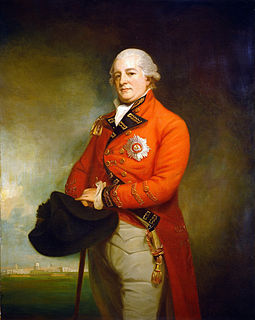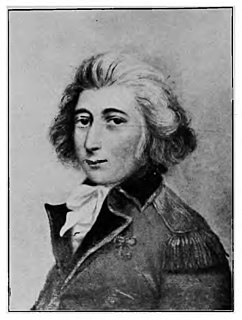
Andrew Pickens was a militia leader in the American Revolution. A planter and slaveowner, he developed his Hopewell plantation on the east side of the Keowee River across from the Cherokee town of Isunigu (Seneca) in western South Carolina. He was elected as a member of the United States House of Representatives from western South Carolina. Several treaties with the Cherokee were negotiated and signed at his plantation of Hopewell.
Fort Tonyn, named for General Patrick Tonyn, was located in present-day Nassau County, Florida, near the hamlet of Mills's Ferry, about 25 miles up the St. Marys River. The fort was unremarkable in its day, seeing little action, and apparently was not even recognized as a fort by the British; the name appears to have been used by the Americans for this British outpost. It is remembered chiefly because it served as a way station in the only substantial campaign Florida saw during the Revolution. General Robert Howe camped near the fort with some 400 men on June 28, 1778, forcing the withdrawal of Lieutenant Thomas Brown and his loyalist East Florida Rangers, who were stationed there as the front line of defense for British East Florida. They burned the fort and retreated into Cabbage Swamp. These events occurred just prior to Colonel Elijah Clarke leading his Continental Army troops to defeat at the Battle of Alligator Bridge on June 30, the only major engagement in an unsuccessful campaign to conquer British East Florida during the American Revolutionary War.
The Battle of Alligator Bridge took place on June 30, 1778, and was the only major engagement in an unsuccessful campaign to conquer British East Florida during the American Revolutionary War. A detachment of Georgia militiamen under the command of General James Screven chased Thomas Brown's Loyalist company into a large position of British regulars established by British Major Mark Prevost and were turned back.
Richard Howly, sometimes spelled Howley, was an American planter and lawyer from Liberty County, Georgia. He served briefly as the Governor of Georgia in 1780, as a delegate to the Continental Congress in 1780 and 1781, and as Chief Justice of Georgia in 1782 and 1783.

The Battle of Kettle Creek was the first major victory for Patriots in the back country of Georgia during the American Revolutionary War that took place on February 14, 1779. It was fought in Wilkes County about eight miles (13 km) from present-day Washington, Georgia. A militia force of Patriots decisively defeated and scattered a Loyalist militia force that was on its way to British-controlled Augusta.

The siege of Fort Motte was a military operation during the American Revolutionary War. A force of Patriots led by General Francis "Swamp Fox" Marion and Lt. Colonel "Light Horse" Harry Lee set out to capture the British post at Fort Motte, the informal name of a plantation mansion fortified by the British for use as a depot because of its strategic location at the confluence of the Congaree and Wateree rivers. The British garrisoned roughly 175 British soldiers under Lt. Daniel McPherson at the fort.

The Southern theater of the American Revolutionary War was the central theater of military operations in the second half of the American Revolutionary War, 1778–1781. It encompassed engagements primarily in Virginia, Georgia and South Carolina. Tactics consisted of both strategic battles and guerrilla warfare.

Colonel John Dooly (1740–1780), born in Wilkes County, Georgia, was an American Revolutionary war hero. He commanded a regiment at the Battle of Kettle Creek in 1779 and was killed at his home by Tories in 1780.
The Battle of Thomas Creek, or the Thomas Creek Massacre, was an ambush of a small force of Georgia militia cavalry by a mixed force of British Army, Loyalist militia, and Indians near the mouth of Thomas Creek in northern East Florida. The encounter was the only major engagement in the second of three failed attempts by American forces to invade East Florida in the early years of the American Revolutionary War.
Sawpit Bluff was a small settlement in East Florida during the American Revolutionary War, on the site of a plantation at the mouth of Sawpit Creek where it discharges into Nassau Sound opposite the south end of Amelia Island. It was the location of a proposed rendezvous between mounted militia from Sunbury, Georgia and Continental troops under the command of Lt. Col. Samuel Elbert during the second invasion of Florida in May 1777.
Thomas "Burnfoot" Brown was a British Loyalist during the American Revolution. Intending to become a quiet colonial landowner, he lived, instead, a turbulent and combative career. During the American Revolutionary War he played a key role for the Loyalist cause in the Province of Georgia as a Lt. Col in the King's Carolina Rangers. Following the overthrow of British rule and the Patriot victory in the Revolution, Brown was exiled first to British East Florida, and later to St. Vincent's Island in the Caribbean.

The Battle of Brier Creek was an American Revolutionary War battle fought on March 3, 1779 near the confluence of Brier Creek with the Savannah River in eastern Georgia. A mixed Patriot force consisting principally of militia from North Carolina and Georgia along with some Continental regulars was defeated, suffering significant casualties. The rout damaged Patriot morale.

The Capture of Savannah, or sometimes the First Battle of Savannah, or the Battle of Brewton Hill, was an American Revolutionary War battle fought on December 29, 1778 pitting local American Patriot militia and Continental Army units, holding the city, against a British invasion force under the command of Lieutenant Colonel Archibald Campbell. The British capture of the city led to an extended occupation and was the opening move in the British southern strategy to regain control of the rebellious Southern provinces by appealing to the relatively strong Loyalist sentiment there.
The siege of Augusta took place between May 22, 1781, and June 6, 1781. American Patriot forces, led by General Andrew Pickens and Colonel Henry "Light Horse Harry" Lee, were successful in capturing Augusta, Georgia held by British loyalist militia. Fort Cornwallis, the primary British defence, was successfully exposed to cannon fire by the construction of a tower 30 feet (9.1 m) high on which the Americans mounted a small cannon. The British surrendered on June 6.
The Province of Georgia was a significant battleground in the American Revolution. Its population was at first divided about exactly how to respond to revolutionary activities and heightened tensions in other provinces. When violence broke out in 1775, radical Patriots took control of the provincial government, and drove many Loyalists out of the province. Georgia also served as the staging ground for several important raids into British-controlled Florida.

Andrew Deveaux was an American Loyalist from South Carolina who is most famous for his recapture of the Bahamas in 1783.
William "Bloody Bill" Cunningham (1756–1787) was an American loyalist infamous for perpetrating a series of bloody massacres in South Carolina's backcountry in the fall of 1781 as commander of a Tory militia regiment in the Revolutionary War. Though his family were loyal to the British crown, Cunningham initially enlisted in the Continental Army as part of the State of South Carolina's 3rd regiment in 1775. His tenure in the rebel army was an unhappy one and Cunningham changed sides to fight for the British in 1778. He earned the nickname "Bloody Bill" for the violent, ruthless nature of his raids on rebels and patriot civilians.

Colonists who supported the British cause in the American Revolution were Loyalists, often called Tories, or, occasionally, Royalists or King's Men. George Washington's winning side in the war called themselves "Patriots", and in this article Americans on the revolutionary side are called Patriots. For a detailed analysis of the psychology and social origins of the Loyalists, see Loyalist.

Fort Morris is an earthen works fort in Liberty County, Georgia, in the United States. The fort is on a bend in the Medway River and played an important role in the protection of southeast Georgia throughout various conflicts beginning in 1741 and ending in 1865 at the conclusion of the American Civil War, including the French and Indian and American Revolutionary Wars and War of 1812. The historic site is 70 acres (28 ha) in size and sits at an elevation of 23 feet (7.0 m).
Daniel McGirt, also given as McGirtt or McGirth,, a native of the Camden District in South Carolina, was the leader of an outlaw gang that operated in northern Florida and southern Georgia during the latter 1700s. Mostly uneducated, he made a living as a hunter and trapper until the American Revolutionary War broke out, whereupon he served for a while as a scout for the Continental Army, then switched sides, and became one of the more picturesque minor figures of the war.









